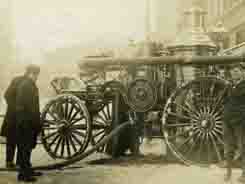
Fire Brigade
GRHC - May 2nd, 2012
The city's early fire brigades were volunteer organizations, the church bell at St. Andrews Cathedral was one of two fire alarms, and horses had to be harnessed before the engine could leave the fire house.
Transcript
All the early records of Grand Rapids were lost on July 12, 1844 when fire destroyed the Court House, which was located on the present site of Fulton St. Park. Following that fire the village purchased a small hand engine built by a local manufacturer. Water was poured into it by the volunteer “bucket brigade”, while another crew stood on each side and pumped for all they were worth.
The village purchased its first steam fire engine in 1865 at a cost of $5600. It was named the David Caswell in honor of a former chief. A second steamer, acquired in 1868, was called the Louis Campau. In 1872 a much larger machine, the Valley City, was added.
Horses to draw the fire engines were rented from private owners and housed in Engine House No. 1 at the corner of LaGrave and Weston. It took about twelve minutes to hook up and take off for a fire.
The alarm system was very crude. Bells in the engine house were rung by hand from information supplied by passers-by. If a fire occurred in the north end, the whistle on the C.C. Comstock factory would be blown. Ringing the bell in St. Andrews Cathedral announced a fire in the south end. In 1872 an electrical alarm system was introduced, which notified all stations simultaneously of a fire. This was a decided improvement and a giant step forward in fire protection.
Full Details
| Title | Fire Brigade |
|---|---|
| Creator | GRHC |
| Keywords | WYCE; radio; Grand Rapids; Historical Commission; history; fire engines; horses |
| Duration | 2:05 |
| Pubdate String | May 2nd, 2012 |

 facebook
facebook